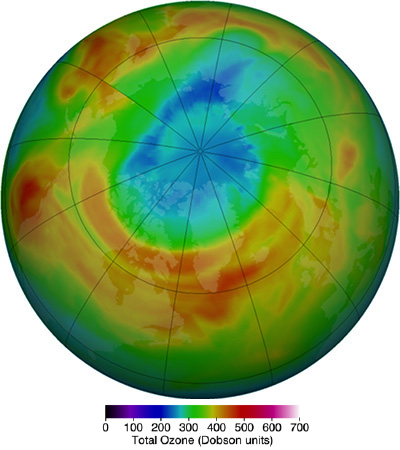Chlorine makes a comeback
Circulation slowdown allows ozone-destroying chemical to rebuild in Northern Hemisphere
Nov 5, 2014 - by Staff
Nov 5, 2014 - by Staff
November 5, 2014 | Concentrations of hydrogen chloride (HCl), the main reservoir of chlorine in the stratosphere, have increased by several percent over much of the Northern Hemisphere since 2007, a new study finds. The observed buildup in HCl is attributed to a temporary shift in atmospheric circulation, rather than to any increased emission of the chlorine-containing, ozone-destroying compounds that are banned by the Montreal Protocol.

Ozone concentrations above the Arctic in March 2011 (shown above in Dobson units) reveal significant depletion. In mid-March, more than 40% of the ozone above some locations was removed. The loss was produced by excess hydrogen chloride and persistent cold temperatures. Ozone loss over the Antarctic, often referred to as the "ozone hole," has similar chemical origins. (NASA image courtesy James Hannigan, NCAR.)
A team of researchers from 15 institutions in 9 countries conducted the analysis, published in Nature this week. The authors include NCAR’s Michael Coffey and James Hannigan.
Atmospheric chlorine is closely monitored because of the danger it poses to the stratospheric ozone layer, which protects people and ecosystems from harmful ultraviolet radiation. For more than 20 years, the Montreal Protocol and its extensions have restricted emissions of the chemicals most likely to damage the ozone layer, including chlorofluorocarbons (CFCs), which release chlorine atoms when they break up.
“We found no evidence that new sources of chlorine are responsible for the increase in HCl,” says NCAR’s Hannigan. “This suggests that the Montreal Protocol continues to be effective in reducing chlorine emissions, although we may see natural variations from time to time in the amount of chlorine held in the atmosphere.”
The culprit for the HCl increase appears to be a temporary slowing of the Brewer-Dobson circulation, which brings stratospheric air downward over middle and high latitudes of the Northern Hemisphere in winter. As a result of this slowdown, the wintertime stratosphere air has been “older”—refreshed about every 3.4 years rather than every 3 years. This has provided more time for a larger fraction of the CFCs within the aged air to be converted into HCl.
The unexpected increase in stratospheric HCl was found at a variety of latitudes across the Northern Hemisphere through the globe-spanning Network for the Detection of Atmospheric Composition Change. The result was corroborated by satellite observations and analyzed with model simulations. In the Southern Hemisphere, HCl in the stratosphere continues to decrease as expected.
The study left for further analysis the question of what may be causing the post-2007 stratospheric circulation slowdown, cautioning that “such variability and its causes will have to be thoroughly characterized and carefully accounted for when evaluating trends or searching for ozone recovery.” Regardless of its origin, Hannigan noted, the current path to excess chlorine in the Arctic stratosphere creates a situation where high ozone loss can still occur.
In a report issued in September, the World Meteorological Organization confirmed that most of the substances regulated under the Montreal Protocol continue to decrease. Scientists expect that ozone levels will have recovered to 1980-era values by midcentury over the Arctic and above midlatitudes in both hemispheres, with the recovery delayed somewhat over the Antarctic.
E. Mahieu, M.P. Chipperfield, J. Notholt, T. Reddmann, J. Anderson, P.F. Bernath, T. Blumenstock, M.T. Coffey, S.S. Dhomse, W. Feng, B. Franco, L. Froidevaux, D.W.T. Griffith, J.W. Hannigan, F. Hase, R. Hossaini, N.B. Jones, I. Morino, I. Murata, H. Nakajima, M. Palm, C. Paton-Walsh, J.M. Russell III, M. Schneider, C. Servais, D. Smale, and K.A. Walker, Recent Northern Hemisphere stratospheric HCl increase due to atmospheric circulation changes, Nature, doi: 10.1038/nature13857
Writer/contact
Bob Henson, UCAR/NCAR Communications
Collaborating institutions
Hampton University
Jet Propulsion Laboratory
Karlsruhe Institute of Technology
National Center for Atmospheric Research
National Institute for Environmental Studies, Japan
National Institute of Water and Atmospheric Research, Japan
Old Dominion University
Tohoku University
University of Bremen
University of Leeds
University of Liège
University of Wollongong
University of Toronto
University of Waterloo
University of York
Funders
Australian Research Council
AWI Bremerhaven
Belgian Science Policy Office
Canadian Space Agency
Danish Meteorological Institute
Federation Wallonie–Bruxelles
Fonds de la Recherche Scientifique, Belgium
International Foundation High Altitude Research Stations Jungfraujoch and Gornergra
MeteoSwiss Ministry of Business, Innovation and Employment, New Zealand
NASA National Oceanic and Atmospheric Research
National Science Foundation
State Meteorological Agency, Spain
UK National Environment Research Council